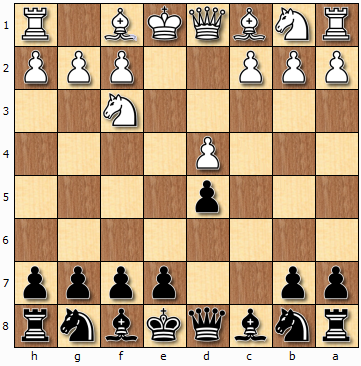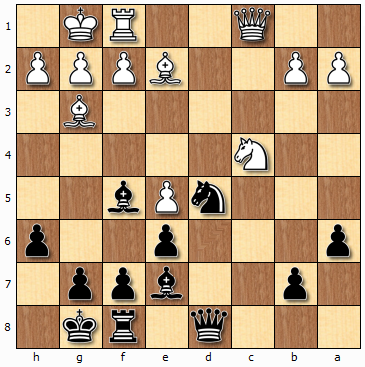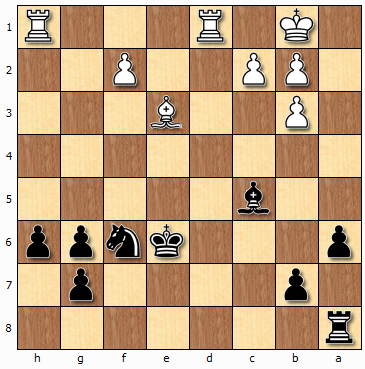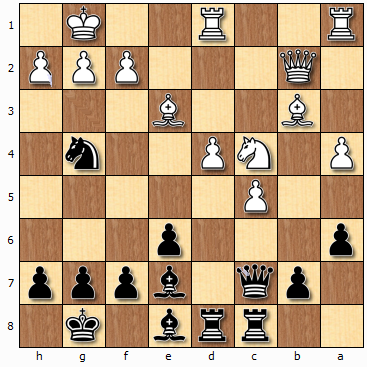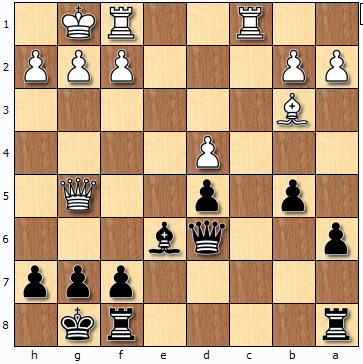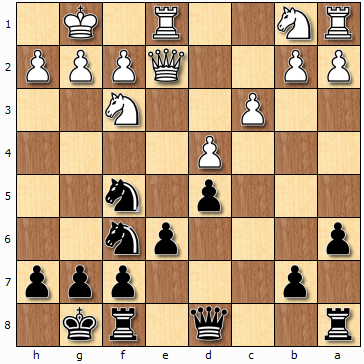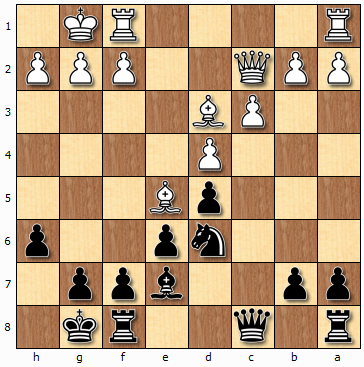19:24 The Caro-Kann defense with 2. Nf3, Part 1 |
|
We consider the variation: 1. e4 c6 The strongest respond from Black is: 2. … d5 Thus, the e4 pawn is attacked. White has the two options to defense it. They are: 3. d3 and 3. Nc3. Also, White can exchange this pawn with Black’s d pawn or move it to the e5 sqaure. Firstly, we consider the variation where White prefers to exchange the pawn: 3. ed cd Now White can convert the game to the exchange variation of the Caro-Kann defense:
Here are possible many options for Black, for example, 4. … N c6. In this case, the following opening may occur: 5. c3 N f6 6. B f4 B f5 7. N bd2 a6. Now if 8. B e2 then 8. … e6 9. 0-0 h6 (to prepare the h7 square for the bishop in the case of 10. N h4) 10. N e5 N x e5 11. de N d7 12. c4 N b6 13. cd N x d5 14. B g3 R c8 15. R c1 R x c1 16. Q x c1 B e7 17. N c4 0-0. =>
In this variation, White puts its knight to the d6 square and Black should be accurately to neutralize it. There is an alternative variation for Black to avoid the variation where White puts a knight to the d6 square. That’s 11. … g5, but this leads to the very difficult game. If 8. Q b3 then 8. … N a5 9. Q a4 b5 10. Q d1 e6 11. B e2 B d6 12. B x d6 Q x d6 13. N e5 h6 14. B d3 B x d3 15. N x d3 0-0. =>
If 5. N e5 then 5. … a6 6. c4 e6 7. N x c6 bc 8. N c3 N f6 9. c5 Be7 10. b4 0-0 11. B e2 Q c7 12. B e3 e5 13. 0-0 B f5. =>
Also, the last variation may appear in the case of 4. … a6 after 5. N e5 N c6. In the case of 4. … a6 White may respond 5. N c3. If so it’s not good idea for Black to play this way: 5. … B g4 6. h3 B h5 because: 7. g4 B g6 8. h4 h6 9. N e5 B h7 10. g5 e6 11. g6 B x g6 12. N x g6 fg 13. B h3 Q x h4 14. Q e2 N c6 15. Q x e6 Q e7 16. N x d5 Q x e6 17. B x e6 N x d4 18. N c7 + K e7 19. B g5 + N f6 20. N x a8 K x e6 21. 0-0-0 B c5 22. B e3 N b3+ 23. K b1 R x a8 24. ab =>
And White has a much better chance to win. In the case of 4. … a6 5. Nc3 it’s better for Black to play 5. … N c6 6. B f4 B f5 7. B d3 B x d3 8. Q x d3 N f6 9. 0-0 e6 10. h3 h6 11. N e5 B d6 12. N x c6 bc 13. B x d6 Q x d6 14. R c1 0–0 15. N a4 N e4. =>
I prefer to play: 4. … N f6 The most popular respond for White is 5 . c4. Thus, game may continue: 5. c4 dc
There might be 7. Q e2 If so the game may continue: 7. … N c6 8. 0-0 Be7 9. R d1 a6 10. a4 0-0 11. N c3 N b4 12. Ne5 B d7 13. B f4 N bd5 14. B g5 N x c3 15. bc R c8 16. B d2 Q c7 17. B b3 R fd8 18. c4 B e8 19. B f4 Q b6 20. Q d3 N h5 21. B e3 Q c7 22. Q e2 N f6 23. B f4 Q b6 24. Q b2 Q c7 25. c5 N h5 26. B e3 N f6 27. N c4 N g4. =>
In this variation, Black experiences some difficulty just after exit from opening for several moves and should be accurately. Also there is the very dangerous variation for Black with the forced moves started from the tenth move till the twentith move: 7. … N c6 8. 0-0 N x d4 9. N x d4 Q x d4 10. R d1 Q b6 11. N c3 B d7 12. B g5 B c6 13. N b5 B e7 14. B e3 Q a5 15. a3 N d5 16. b4 Q d8 17. B x d5 ed 18. B c5 K f8 19. R ac1 B x c5 20. R x c5 h5 21. N d4 R h6 22. h3 Q g5 23. b5 B d7 24. Q f3 R d6. =>
So, the both variations with 7. … Nc6 leads to the difficult game for black that causes the forced moves. That’s might be not comfortable game for somebody. Therefore, l was looking for the variation where Black may avoid the forced moves. Thus, I researched the variation with 7. … a6. Firstly, I discovered White can’t cause the problems for Black identical to the problems White causes in the previous variation: 1. e4 c6 2. N f3 d5 3. ed cd 4. d4 N f6 5. c4 dc 6. B x c4 e6 7. Q e2 a6 8. a4 N c6 9. 0-0 N x d4 10. N x d4 Q x d4 11. Rd1 Qh4 =>
Contrast to the previous variation, here Black makes the “11. … Q h4” move that allows to avoid the forced moves and gets the comfortable game for Black. The difference is that White can’t play 11. B b4+ because of the pawn in the a6 square. That’s check leads to the losing position for Black in this layout. That’s why Black plays 11. … Q b6 in the previous variation and gets the position where Black has to make the forced moves. However, I saw soon that White may cause other nuisance for Black in the case of 7. … a6: 1. e4 c6 2. N f3 d5 3. ed cd 4. d4 N f6 5. c4 dc 6. B x c4 e6 7. Q e2 a6 8. 0-0 b5 9. B b3 B e7 10. N c3 0-0 11. B g5 N c6 12. R ad1 N d5 13. N x d5 B x g5 14. N c3 N a5. =>
Now thanks to White’s Rook targets to Black’s queen White’s the d pawn may take Black’s the e pawn and the f pawn while Black is able to win back one pawn only: 15. d5 N x b3 16. de Q e7 17. ef+ R x f7 18. N x g5 Q x g5 19. ab B b7 20. f3 R af8. =>
As result Black has one pawn more than White has in the endgame. Though Black gets the drawish position, it can rely to make a draw, but not to play for winning. There might be 13. … ed. However, I this case White gets the positional advantage: 13. ... ed 14. N e5 B x g5 15. N x c6 Q d6 16. Q e5 Q x c6 17. Q x g5 B e6 18. R c1 Q d6. =>
Since I didn’t find in the database the proper respond to the 7. Q e2 so that Black should avoids any troubles mentioned above I came up with my own variation. This variation begins with the respond to the seventh White’s Q e2 move that is 7. … h6. This move intends to prevent the development of White’s black-square bishop to the g5 square. The further plan of Black is to block the White’s d pawn with a knight. If the White’s c3 knight takes the blocking knight then Black wins a knight back taking the White’s knight with the e pawn. The absence of the White’s bishop in the g5 square does not give the positional advantage for White as it happens in the previous variation considered. Here is my variation: 1. e4 c6
Currently we consider the following variation: 1. e4 c6
In the part 2, we considered the variations where White plays 5. c4. This is most popular move. While one of strongest respond is to develop the bishop to the f4 square: 5. B f4. Why is the development of the bishop to the g5 square is not so preferred option? Firstly, the bishop pierces the whole queen side from the f4 square. But most importantly, the bishop located in the g4 square is attacked by the knight: 5. … N e4. Let us consider the variation with 5. B g5 N e4 firstly. Now it’s not good for White 6. B d3 because: 6. … N x g5 7. N x g5 e5 and White’s knight is attacked. The best option for Black is to play 8. N x h7. Though Black takes a pawn, its knight is in a bad position. After 8. … Q b6, Black threats to win the material by moving e4. It’s mistake for White to move 9. de because 9. … Q x b2 10. N d2 Q x e5 +. If 11. K f1 then 11. … B e7 12. N f3 Q h5 13. N fg5 Q x d1+ 14. R x d1 N a6 (now if White’s bishop leaves the b1 – h7 diagonal then White loses a knight. For example, 15. B x a6 ba 16. R x d5 f6 17. N x f6 B x f6) 15. N f3 (to prepare the g5 square for the h7 knight) 15. … B d7 (again White can’t play 16. B x a6 because 16. … ba 17. N hg5 f6 18. N h3 B b5 + 19. K e1 B b4 + 20. R d2 B x d2 21. K x d2 g5 and Black wins the material and gets the better position. If 20. N d2 then might be 20. … 0-0 21. R b1 R fe8 + 22. K d1 B e2 + 23. K c1 B a3 + 24. R b2 B x b2 25. K x d2. Again, Black wins the material and gets the much better position. If 19. K g1 then 19. … B e2 20. R c1 B x f3 21. gf R x h3 and Black loses too much material.) 16. h4 N b4 17. N hg5 N x d3 18. cd f6 19. N h3 g5 and White is experiencing big problems. If 20. hg fg 21. N d4 g4 and White loses the material. Therefore 20. N hg1 R c8 21. N d4 B c5 and Black’s position is much better as all its pieces are active, but only a knight is active in Black side. Besides three White’s pieces are located in the first horizontal while all Black pieces are developed. To view the main line click this button => If 11. Q e2 then 11. … Q x e2 12. K x e2 B e7 13. h4 N c6 14. N g5 N d4 + 15. K e3 B c5 16. K f4 R h6 17. R ae1 + K f8 18. N b3 B d6+ 19. K e3 N c6. As result Black gets a weak king in the board where there are too many pieces. While Black gets the advantage of the two bishops in the open position. To view the main line click this button => It’s better for White to play 9. N x f8. But this does not help for White so much. Black wins a pawn anyway. The game may continue: 9. … e4 10. B e2 Q x b2 11. N d2 Q c3 12. N g6 fg 13. 0-0 N c6. The d4 pawn is attacked and White continues defensing it: 14. N b3 0-0. Now Black threats to win a pawn by moving N b4. For example, 15. B b5 N b4 16. N c5 Q x c2 17. a3 Q x d1 18. R f x d1 N c6. Therefore, 15. R c1 a5 16. B b5 a4. Now the knight may escape to the d2 square only. Otherwise, if 17. N c5 b6 18. N x e4 de and Black wins a knight. If 17. N a1 then 17. … N x d4 18. B e2 e3 19. f3 B f5 20. R b1 R fe8 21. Re1 N x e2 22. Q x e2 d5 23. Q b5 K h7 24. h3 B x c2 25. N x c2 Q x c2 26. R e2 Q f5 and the two connected passed pawns decide the outcome of the game. Therefore, 17. B x c6 Q x c6 18. N d2 Q f6 19. Q e2 Q x d4 and Black wins a pawn again. Now Black’s king is weak. But it’s ok because Black may force the queen exchange: 20. c3 Q c5 21. c4 e3 and White’s queen has to take the e3 pawn and the queen exchange is inevitable. To view the main line click this button => Therefore, White does not play 6. B d3, but 6. B f4. If so, the game may continue: 6. … B f5 7. Bb5+ Nd7 8. 0-0 a6 9. B d3 e6 10. R e1 N df6 11. Q e2 B d6 12. B x d6 N x d6 13. B x f5 N x f5 14. c3 0-0. =>
I’d like to comment this opening a bit. Why does White play 7. B b5 + ? Why does White not develop its bishop to the e2 square or to the d3 square? The answer is that White forces Black to develop its knight to the d7 square instead of the c6 square that is a more perspective position for knight. What’s wrang with the development of the knight to the c6 square after 7. B b5+ ? If Black plays 7. … N c6 White responds 8. c4. The fact is that Black has to exchange its d pawn to White’s c pawn after 8. c4 (it’s not obligatory to do it immediately) or Black gets worse position than White. But after the pawns exchange White’s bishop takes the c6 knight and Black has to take White’s bishop with the b pawn. As result Black gets the weak double pawn and its black-square bishop is not developed while all the White’s pieces are developed and White has a nice pawn structure. In this situation, it’s very difficult to play with Black because, after exit from opening, Black has too few responds to every White’s move while White owns the wide range of moves. Here is example of such variation: 7. … N c6 8. c4 Q a5 + 9. N d2 dc 10. a4 a6 11. B x c6 bc: =>
Now let us understand why it’s bad for Black not to exchange the pawns. For example, Black avoids from the pawns exchange and plays: 9. … e6. If so then after 10. 0-0 Black has a single good move that is 10. … N x d2. What happens otherwise? Say, Black plays 10. … B e7. Then the game continues: 11. N e5 R c8 12. g4 B g6 13. N x g6 hg 14. N x e4 de 15. d5 ed 16. Q x d5 Q b6 17. Q x e4 and White wins a pawn. Thus, the best for Black the following game: 10. … N x d2 11. B x d2. Again, Black has a single good move that is 11. … B b4. What if Black plays 11. Q b6. If so the game continues: 12. B x c6 bc 13. cd ed 14. Q e2 + B e6 15. N g5 K d7 and Black gets a weak king and loses castling. This position is much worse than White’s position. Therefore, the best game for Black is the following: 11. … B b4 12. cd and Black has a single good move again. This move is 12. … Q x b5. What happens otherwise? For example, 12. … ed 13. B x c6 bc 14. Q e1 + B e6 15. B x b4 and White wins a bishop. Therefore, the best game for Black is the following: 12. … Q x b5 13. dc bc 14. a4 Q b7 15. B x b4 Q x b4 16. N e5 R c8 17. R c1. Again, Black has a single good move that is 17. … Q x b2. Otherwise, for example, 17. … Q b7 (if 17. … 0-0 then 18. B3 f6 19. N x c6 and White wins a pawn and gets the much better position) 18. Q f3 Q x b2 19. N x c6 a6 20. d5 0-0 21. N e7 + and Black loses the material or Black can’t make a castling what is very dangerous in this situation. Therefore, the best game for Black is the following: 17. … Q x b2 18. N x c6. Now Black has the two options. First one is 18. … B e4. And other one is 18. … Q b7. First option is better. Otherwise, for example, 18. … R a8 19. R e1 0-0 20. d5 ed 16. N e7 + and Black loses the material. Therefore, the best game for Black is the following: 18. … B e4 19. N x a7 R a8 20. R e1 0-0 21. N b5 B f5 22. N c7 R a7 23. N b5 R a8 24. d5 ed 25. Q x d5 B g6 26. Q c4 Q d2 and Black has one pawn less than White has. Besides, we see that almost all moves for Black are forced. It is therefore it’s better for Black to exchange the pawns after 8. c4. To view the main line click this button => Let us come back to fifth White’s move. We just considered the variation with 5. B g4. However, the strongest respond for White is 5. B f4. In this variation, the game may continue: 5. B f4 B f5 6. c3 N c6 7. N bd2 e6 8. Q b3 Q c8 9. N h4 B e4 10. N x e4 N x e4 11. B d3 B e7 12. N f3 O-O 13. N e5 N x e5 14. B x e5 N d6 15. Q c2 h6 16. O-O. =>
And Black may do the pawn minority attack. |
|
|
| Всего комментариев: 0 | |

